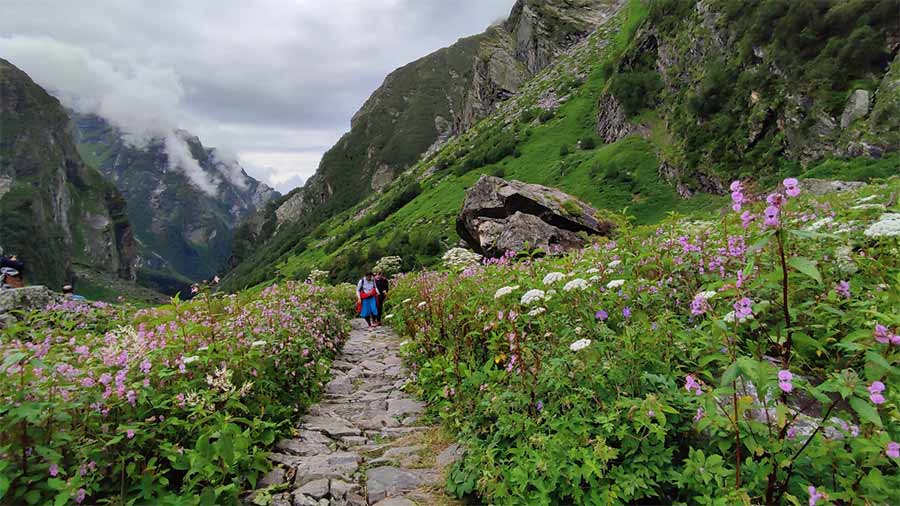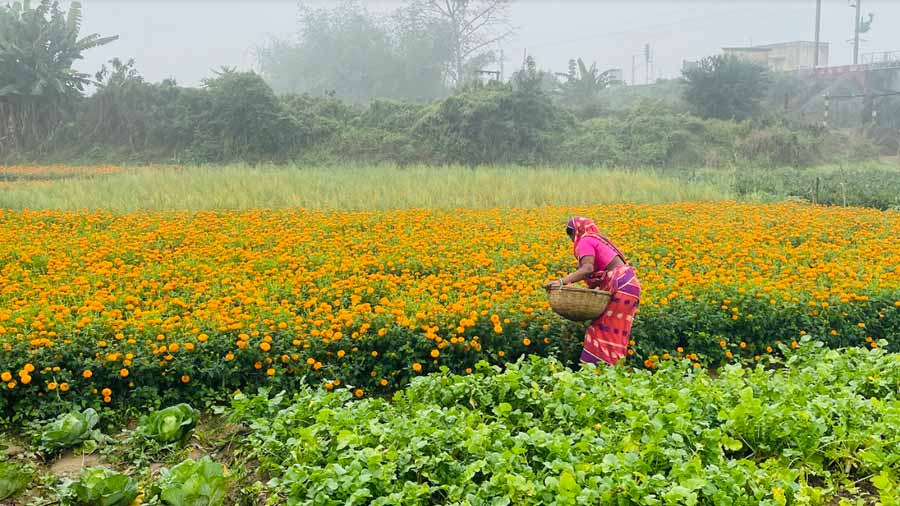Bhyundar Valley, also known as Valley of Flowers, located in the state of Uttarakhand, was accidentally discovered in 1931 by mountaineer Francis Sydney Smythe, aka Frank Smythe, and botanist R.L. Holdsworth along with four other members who were returning from a successful expedition of climbing Kamet, a mountain (7,756 m) situated in the Garhwal Himalayas.
In Smythe’s words, “It was impossible to take a step without crushing a flower.” Though Bhyundar Valley and its flowers were well known to the locals, Frank Smythe introduced it to the world under a new name — 'Valley of Flowers'. He returned to the area in 1937 for detailed exploration of the area. The altitude of the valley ranges between 11,000 to 12,000 feet above sea level.
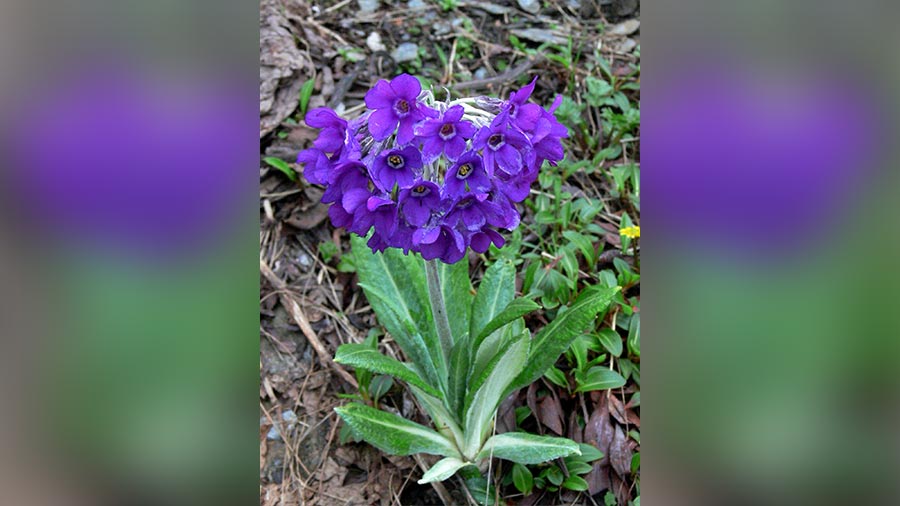
'Primula macrophylla' – the first species of flower sighted by Frank Smythe and R.L. Holdsworth in the valley Dr G.S. Goraya
There is an abundance of flowers in the valley from June and stays till September, which attracts several trekkers from all over the world. The trek starts from Ghangaria, a remote village but having all modern amenities.
Since the crowd is less in August and so is the rain, I decided to visit the valley with my friends Subho and Amit in the first two weeks of the month. We decided to add the Hemkund Sahib Trek, which is just adjacent to it.

Flowers of the Valley (L to R) Row 1: 'Selinum wallichianum', 'Aster albescens', 'Heracleum candicans'; Row 2: 'Cyananthus lobatus', 'Potentilla atrosanguinea', 'Taraxacum officinale' Amitabha Gupta
We reached Joshimath (6,150 feet) around 4pm on a sunny afternoon after an eight-hour journey covering 275 km in a hired car from Haridwar. We were to reach Govindghat the next day, early in the morning, located just 22 kms away. Earlier the trek would start from Govindghat itself but now an additional distance of 7 km was motorable. At Joshimath, we paid a visit to the local Narsingh Temple.
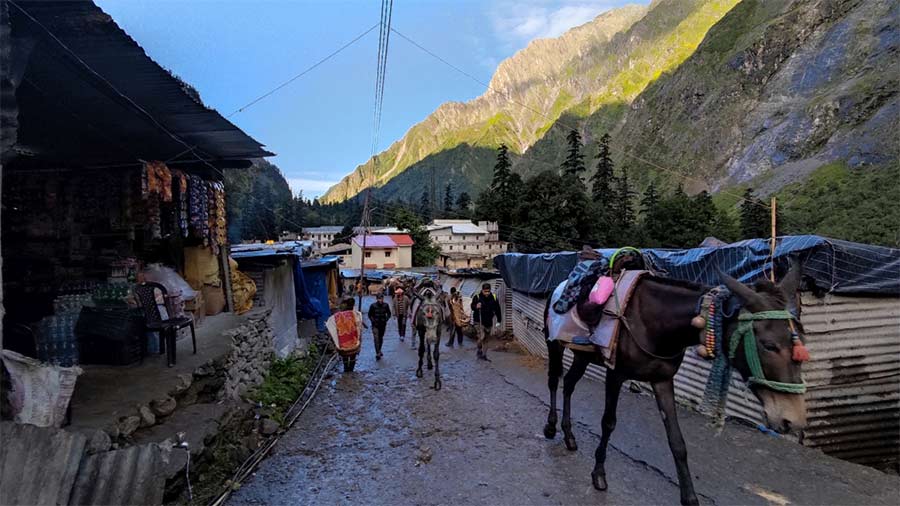
Ghangaria in the morning hours – the starting point of Valley of Flowers trek Amitabha Gupta
It started raining the next morning. Luckily, it stopped when we reached Govindghat. There were Tata Sumos available that charged us Rs 500 for a full vehicle to reach the starting point of the trek. After crossing the hanging bridge over Alaknanda river, we reached our trek start point within 15 minutes. We had booked our driver Joshiji for the whole tour, so he was to stay back with the car at Joshimath till we came back.
The trek to Ghangaria (10,000 feet) was uneventful. The porter charged Rs 1,100 for carrying three sacks and the porter association charged a token amount. Except the Alakananda river crossing, from where one climbs uphill to Ghangaria, nothing is interesting in this 13km stretch. There are several eateries on the way where you can have lunch. There are helicopter services as well between Govindghat to Ghangaria. We saw helicopters flying several times on the way. The helicopter service charge for one way ride from Govindghat to Ghangaria and vice versa is Rs 2,895.
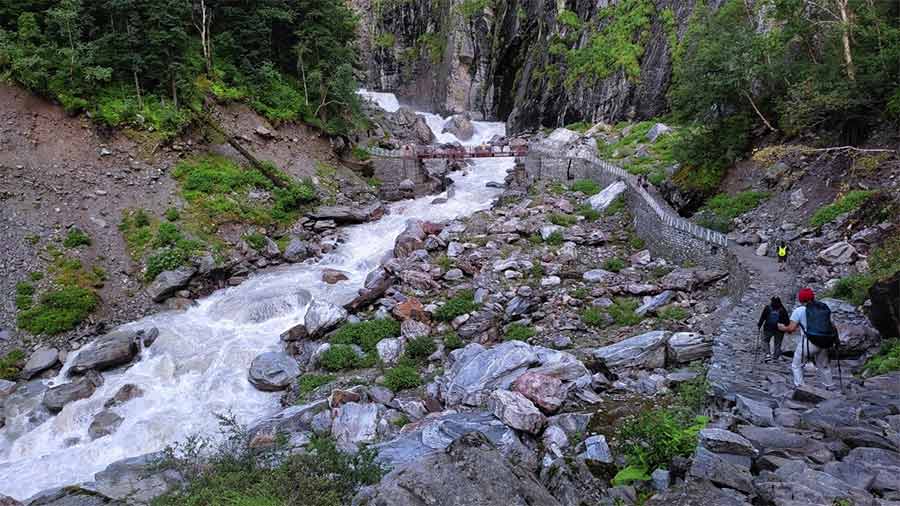
Trekkers walking towards the main bridge over Pushpawati river, which runs through the Valley of Flowers
Our stay for the night, Himalayan Homestays, was located at the entry point of Ghangaria. We settled in our rooms which were comfortable enough. After having our evening snacks, we visited the local auditorium and had a look at the documentary film on the Valley of Flowers. We retired early as we needed to reach the entry gate of Valley of Flowers by 6.45am. The gate opens by 7am. It is a 4km stretch to the valley.
The next day, we started from our hotel at around 6.30am. Entry fee to the valley was Rs 150 per person, which was valid for three days. For every extra day, they charge Rs 50 per day. For foreigners, it’s Rs 600 per head and Rs 250 for an extra day.
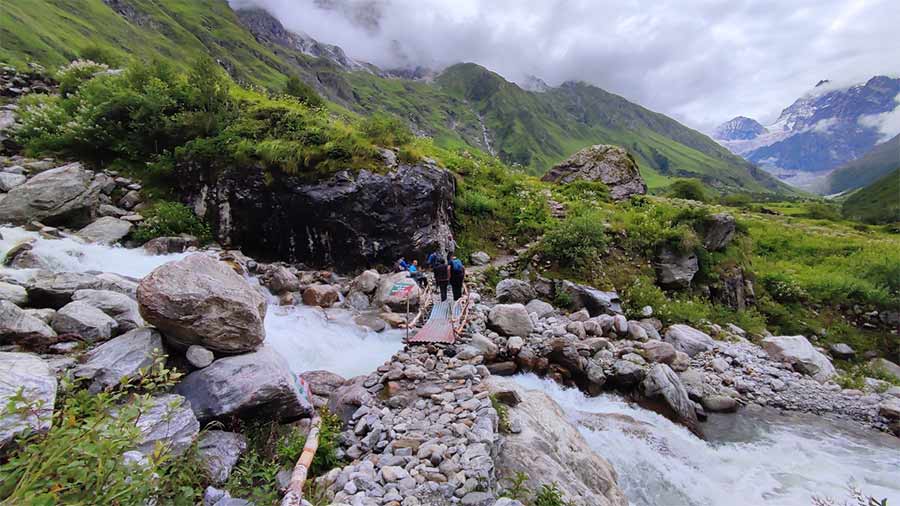
The makeshift bridge over Pushpawati River at the entry point of Valley of Flowers Amitabha Gupta
The river Pushpawati flows through the valley and one has to cross it many times during the trek. Before reaching the main bridge on Pushpawati River, I was lucky to spot blue poppies, a flower rarely seen nowadays in the valley.
From the bridge, there’s an uphill climb of about one hour, followed by another one hour of downhill trek that leads you to the valley. One has to cross a makeshift bridge over Pushpawati River to enter the valley. Once you are inside the valley, it takes some time to grasp the vast landscape with green meadows, a wide variety of flowers and faraway mountains covered with clouds. You get a good view standing near a big rock close to the starting point of the valley.
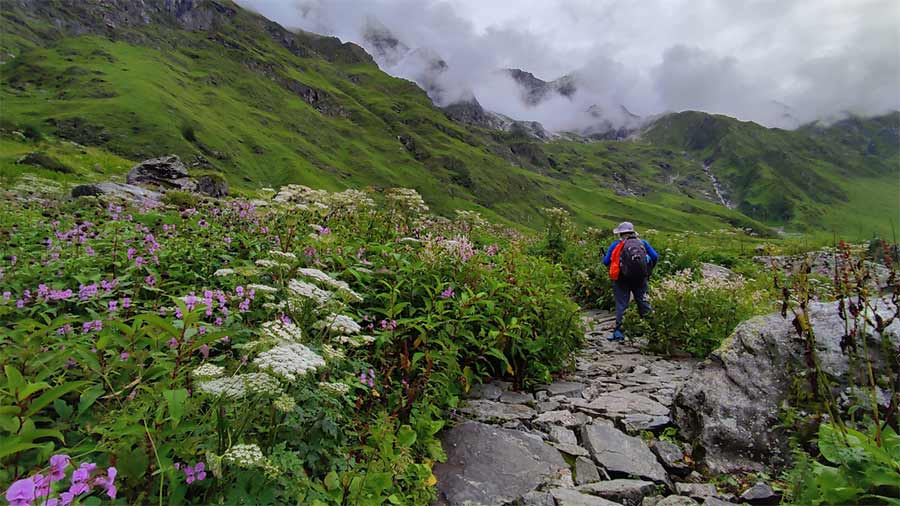
A trekker in the Valley of Flowers
Although not a floral expert, yet I could spot the dark blue ‘Large Bellflower’ (Cyananthus lobatus), yellow coloured ‘Cheerful Sececio’ (Senecio laetus), purplish pink ‘Laljar’ alias ‘Ratanjot’ (Geranium wallichianum) and the dark crimson ‘Ruby Cinquefoil’ (Potentilla atrosanguinea). I could not spot any Primus macrophylla, which was the first species that Frank Smyth and R.L. Holdsworth spotted in the valley, probably because it blooms in June. The most beautiful flowers in the valley are pink coloured Impatiens glandulifera and white Selinum wallichianum with its huge umbrella shaped clusters, available in abundance.
Walking through the wonderlands of flowers for about another 3km takes one to the memorial stone of Grave of Joan Margaret Legg, a botanist who died in the valley. You need to leave the valley by 5pm, so make sure to turn back by 2pm.

Flowers of various colours in the valley Amitabha Gupta
The route to the valley is moderately steep and the pathway is full of loose and slippery stones. If it rains, the chances of twisting an ankle is always there. However, rescue operations are pretty quick there. Our teammate Subho had a bad fall, fracturing his leg. He was promptly airlifted to Govindghat after initial treatment within one hour of the accident.
We had decided to abandon the Hemkund Sahib trek after the incident, but Subho, who left for Delhi airport in Joshiji’s car, insisted that we complete the trek. That adventure may be narrated later.
Travel Tips
- If travelling in a group, always book a car for the whole tour. Our driver Situ Joshi was an immensely responsible driver. His numbers are 8058182111/910138738.
- Travel in August. Hotels are easily available at Ghangaria at that time. The accommodation facilities at Gurudwara are decent enough. There are many hotels too.
- The diet is mainly vegetarian throughout with eggs served in some places. I felt it is better to stay at Govindghat than Joshimath, as there are good hotels there as well. It saves time in the morning.
- Wear ankle high trekking shoes; carry walking sticks and dry foods for having lunch during the trek. Please note that littering, smoking or playing loud music in the valley is prohibited.
- Carry a poncho to avoid getting drenched.
- It is moderately cold late in the night, but not during the day.
